|
Nature Trail:
Glass frogs and walking fish
Wondering whether the two creature featured today are fictional ones?
They certainly may seem so to you not only because of their names but
also their unusual appearance. However, they are real life animals that
are rather rare and strange looking.The Animal Kingdom is teeming with
many such wonderful creatures , some of which are yet to be identified
by scientists. As we have not seen most of these creatures alive or even
in photographs, it is indeed hard to believe that such animals do exist
even when we hear of them or see them in print.
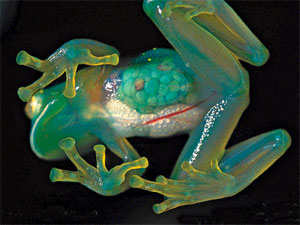  The
Glass frog as the name implies resembles an ornamental frog made of
glass because of its see- through or transparent body.While the general
background coloration of most glass frogs is primarily lime green, the
abdominal skin of some members of this family is transparent. The
internal organs including the heart, liver, and gastrointestinal tract
are visible through this translucent skin, and that is why they have
been given this name. The
Glass frog as the name implies resembles an ornamental frog made of
glass because of its see- through or transparent body.While the general
background coloration of most glass frogs is primarily lime green, the
abdominal skin of some members of this family is transparent. The
internal organs including the heart, liver, and gastrointestinal tract
are visible through this translucent skin, and that is why they have
been given this name.
Imagine being able to see the animalís inner organs right down to the
beating heart? The translucent skin actually has an advantage for the
glass frog because it makes him very difficult for predators to spot, as
he almost becomes a part of the leaf he is sitting on. If you shine a
light on a tree frog at night (if you can find one) all you will see is
his eyes and a smudge for his skull. All frogs in the order Anura which
belong to the amphibian family Centrolenidae are known as glass frogs.
Based on a specimen collected in north eastern Ecuador, the "giant"
Centrolene geckoideum, named by Marcos Jimenez de la Espad, in 1872 was
the first species described. After that several other species were
described but they were initially placed in the same genera as tree
frogs.It was in 1951 that the glass frogs were placed in the
Centolenidae family .
Glass frogs are said to have originated in South America and spread
into Central America. Between the '50s and '70s, most species of glass
frogs were known from Central America, particularly from Costa Rica and
Panama.There are over 60 species of glass frogs living.
The unusual looking glass frogs are small, ranging from 3 to 7.5
centimetres (1.2 to 3.0 in) in length about the size o a fingernail.
They are generally green in colour ,however, the skin along the lower
surface of the body, is translucent. Similar in appearance to some green
frogs and even tree frogs, these frogs have eyes that face forward not
on the sides like most other frogs .
These frogs which are mostly arboreal can be found near rivers and
streams during the breeding season. The female usually lays a clutch of
tiny eggs not in the water but on leaves of trees or shrubs anywhere
from 10 to 20ft up in the air.These leaves must be hanging over running
water of either a stream, small river or creek so that once the eggs
hatch, the tadpoles could fall easily into the water below.
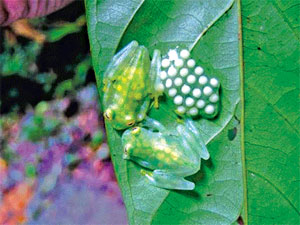 The
method of egg-laying on the leaf varies between species. Even though the
eggs are less vulnerable to predators than those laid within water, they
are likely to be affected by the parasitic maggots of some fly species.
And because of this factor some glass frogs are reported to have shown
parental care about their eggs. Once the tadpoles, which are born with a
strong tail and fins, fall into the river down below the parents return
to the canopy. However ,some glass frog species are known to eat their
young. The
method of egg-laying on the leaf varies between species. Even though the
eggs are less vulnerable to predators than those laid within water, they
are likely to be affected by the parasitic maggots of some fly species.
And because of this factor some glass frogs are reported to have shown
parental care about their eggs. Once the tadpoles, which are born with a
strong tail and fins, fall into the river down below the parents return
to the canopy. However ,some glass frog species are known to eat their
young.
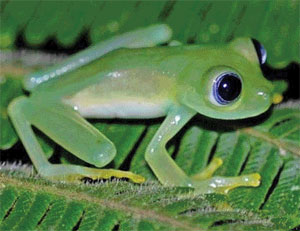
There are 134 species of glass frogs with 60 of them threatened. Of
the rest, 49 are classified as having "not enough data" to classify
their status.In 2004 the International Union for Conservation of Nature
and Natural Resources (IUCN) Red List declared hyalinobatrachium
pellucidum as an endangered species. Fewer than 5,000 exist. The cause
of threat is habitat loss due to small farmers and logging in the
Amazonian slopes of the Ecuadorian Andes. IUCN recorded five specimens
found in 1979 at Río Azuela in Ecuador. Even when assessors have
revisited several times since then, they have found no other glass
frogs.
Glass frogs are important because they are a bioindicator. As the
climate changes, studying how the glass frogs cope will indicate how the
other flora and fauna are handling the changes as well.
The diversity of the natural world is amazing. We need to learn as
much as we can about it to conserve and protect the numerous species of
fauna and flora that is disappearing over the years.
Like many animals the tiny and beautiful glass frogs too need to be
protected. Another fascinating creature that must be conserved is the
Mexican walking fish.The axolotl,(pronounced ax-oh-lot-ul), scientific
name Ambystoma mexicanum is an aquatic salamander native to Mexico,
which is colloquially known as the "Mexican walking fish". Although it
is not a fish, but an amphibian, the Australians and New Zealanders
frequently refer to the axolotl as the Mexican walking fish.
It is actually an amphibian in a paused state of metamorphism.In
general all amphibious fish, some of which are able to spend long
periods of time out of water and also use different types of
locomotion;springing, snake-like lateral undulation, and tripod-like
walking.
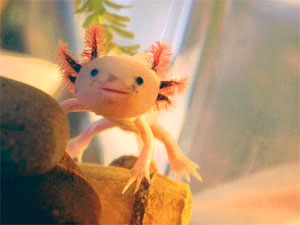 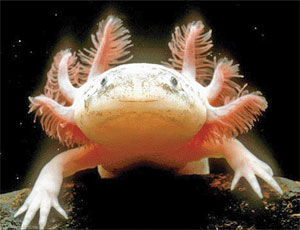 The
axolotl is part of one of the three branches of class Amphibia, which
also includes the frogs and toads (the Anurans), and the mainly eel-like
order, Gymnophiona, which are also known as the Caecilians.If anyone of
you is familiar with the cartoon series Pokemon you may think the
Mexican walking fish inspired the creation of these cartoon characters.
The features of these aquatic creatures, which average about 23
centimetres in length are indeed fascinating. Axolotl have external
gills and a caudal fin that extends from behind the head to the vent.
Branch like gills, which project outwards from the neck, on each side of
the head. Each side is split into three branches, which are covered with
feathery pink filaments.They do not have lids on their eyes . The
axolotl is part of one of the three branches of class Amphibia, which
also includes the frogs and toads (the Anurans), and the mainly eel-like
order, Gymnophiona, which are also known as the Caecilians.If anyone of
you is familiar with the cartoon series Pokemon you may think the
Mexican walking fish inspired the creation of these cartoon characters.
The features of these aquatic creatures, which average about 23
centimetres in length are indeed fascinating. Axolotl have external
gills and a caudal fin that extends from behind the head to the vent.
Branch like gills, which project outwards from the neck, on each side of
the head. Each side is split into three branches, which are covered with
feathery pink filaments.They do not have lids on their eyes .
They have wide heads.There are thin, long digits on their
underdeveloped limbs .They have short legs with four digits in front and
five on the hind feet.The bodies are dark coloured.They prefer a high
altitude water body, that is surrounded by a terrestrial environment,
like most neotenic species. It is found in regions having deep brackish
water and plenty of vegetation. Axolotl is carnivorous and feeds on
small creatures like insects, worms and even small fish. It smells the
food first and then snaps at it and sucks it inside the stomach.
Axolotl is mainly found in the Mexican lakes of Chalco and Xochimilco,
in Mexico city. Unfortunately, the Chalco lake was drained to avoid
flooding and exists no longer. The Xochimilco has diminished too and
exists just as canals. This is why the axolotl have decreased in number
and are classed as an endangered species.
 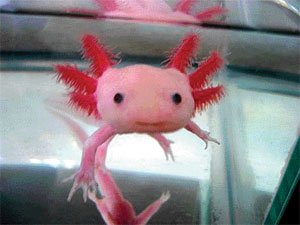 This
little creature with half salamander and half fish like body is on the
verge of extinction. Water pollution and habitat destruction are the two
main reasons responsible for reduction in the number of Mexican walking
fish. Scientists estimate that the number of axolotls, which used to be
around 1,500 per square mile in certain areas, has reduced to just 25.
This is the number of wild axolotls, however, there are large numbers of
axolotls in captivity around the world. This
little creature with half salamander and half fish like body is on the
verge of extinction. Water pollution and habitat destruction are the two
main reasons responsible for reduction in the number of Mexican walking
fish. Scientists estimate that the number of axolotls, which used to be
around 1,500 per square mile in certain areas, has reduced to just 25.
This is the number of wild axolotls, however, there are large numbers of
axolotls in captivity around the world.
The axolotl's unique ability to regenerate the lost body parts is
simply amazing and has caught the attention of medical scientists.Do you
know that they can even restore some parts of their brain? It has long
been known that the axolotl is a worthy study due to its amazing healing
and regeneration abilities.
Normal wound healing in animals occurs through the growth of scar
tissue, which is not the same as the original tissue, nor is it as
robust.
Normal wound healing also does not allow for most animals to re-grow
a lost limb.Despite its endangered status, the use of the axolotl as a
laboratory animal should ensure the species' survival, if only in
captivity.
*************
FAST FACT
Glass frogs
* The glass frog is a freshwater creature that occupies tropical and
subtropical forest territory and inland wetlands, including permanent
rivers, streams, creeks and waterfalls.
* The family Centrolenidae now contains two subfamilies and twelve
genera (Guayasamin et al., 2009).
* Centrolenidae is a diverse type of frogs distributed from southern
Mexico to Panama, and through the Andes from Venezuela and the island of
Tobago to Bolivia, with some species in the Amazon and Orinoco River
basins, the Guiana Shield region, southeastern Brazil, and northern
Argentina.
* The bones are visible from outside and in some species (including
the Pichincha glass frog, the Pacific glass frog, the Cochran glass frog
and lots of others) the bones are green while in other species they are
white.
* A bioindicator is a species that provides clues about the health of
the environment where it lives. As the Earthís weather changes, some of
the rain- and cloud forests where Glass Frogs live are becoming too dry,
making life difficult for the frogs, as well as other plants and
animals. By watching the glass frogs, scientists can learn what impact
global warming has on these forests and the amazing species that inhabit
them.
* Known as the hyalinobatrachium pellucidum (which means translucent
skin), the glass frog is also referred to as the see-through frog,
* While some frogs eat their young, some males are highly territorial
and show parental care.
Mexican walking fish
*Axolotl belongs to the family of 'mole salamanders'. *Amphibians are
a completely separate group of animals even though some attempt to class
them with lizards and reptiles .The fact that reptiles (and human beings
too )have a four-chambered heart while amphibians have only three
chambers is just one example of how appearance can be deceiving:
salamanders might look like lizards, but they are very different indeed.
* Axolotls of various colours occur in captivity, including grey,
shades of brown, leucistic (white with black eyes), golden albino, white
albino, as well as other varieties, such as the melanoid (a near-black
animal).
* The name "axolotl" comes from the Aztec language, "nahuatl". One of
the most popular translations of the name connects the Axolotl to the
god of deformations and death, Xolotl, while the most commonly accepted
translation is "water-dog" (from "atl" for water, and "xolotl", which
can also mean dog).
*The axolotl is fully capable of complete limb re-growth. The animal
has the added scientific attraction of having especially large embryos,
making it easier to deal with under laboratory conditions. Its embryo is
also very robust, and can be spliced and combined with different parts
of other axolotl embryos with a high degree of success.
* Neoteny is sometimes found in other amphibians, but tends to be
caused by low levels of iodine (an essential element for animals to make
thyroxine hormones, necessary for growth and development), or possibly
by random genetic mutation. Research has also shown that very low
temperatures can suppress the production of these hormones, thus also
inducing neoteny.
* An adult Mexican walking fish ranges in length from 15- 45
centimetres
* Mexican walking fish becomes sexually mature at the age of about 12
months. The males can be identified by their longer tails .Females have
a wider body and lay between 300 to 1000 eggs. Larvae hatch within two
to three weeks.
Facts and pix: Internet |

